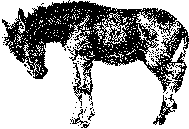
by Benjamin Robert Haydon
Benjamin Robert Haydon, an English painter, born in Plymouth, Jan. 25, 1786, died by his own hand in London, June 22, 1846. Disre-; garding the wishes of his father that he should adopt his own business, that of a bookseller, he went to London at the age of 18, and became a student in the school of the royal academy. He was an enthusiast in the pursuit of what is called "high art," and prosecuted his studies in drawing and anatomy with singular earnest- ness. His first picture, "Joseph and Mary resting with our Saviour after a Day's Journey on the Road to Egypt," was exhibited in 1807, and immediately purchased by Thomas Hope, the author of "Anastasius." This was followed by "Dontatus," a work which established his reputation, but involved him in a quarrel with the academy, whose hanging committee had placed the picture in a small side room. A fondness for controversy led him to publish several attacks upon the academy, which had only the effect of estranging some of his most valuable friends, of exasperating his own temper, and of cutting him off from what was the chief ambition of his life, the honor of being an academician. From this time forward, notwithstanding the frequent production of eminent works, who had constantly to struggle with pecuniary difficulties.
In 1815 he established a school, in opposition to that of the academy, in which the Landseers and Eastlake were instructed, and about the same time became associated in the conduct of a periodical entitled "Annals of the Fine Arts." Having no tact for either pursuit, he failed in both; and in 1823, two years after his marriage, he was so involved in debt that he became an inmate of the king's bench prison, where he remained two months. Subsequently he painted here one of his most characteristic works, "The Mock Election," representing a scene which took place within the prison walls in July, 1827, and which was purchased by George IV. for 500 guineas. For his "Pharaoh and Moses," painted soon after his release, he obtained an equal sum. Notwithstanding these and similar emoluments, in 1836 he again became a prisoner for debt, but was soon after enabled to compound with his creditors. About this time he lectured on painting with considerable success. Upon the publication by government, in great part through Hay-don's own exertions, of proposals for decorating the new houses of parliament with frescoes representing scenes in the history of the nation, he sent to the exhibition in Westminster hall two cartoons, "The Curse" and "Edward the Black Prince." No notice was taken of his performances, and his hope of executing some great public work of art was crushed for ever.
To show the world how erroneous had been the decision of the judges, he commenced a series of gigantic pictures, including " Uriel and Satan," "Curtius Leaping into the Gulf," the " Burning of Rome," and the " Banishment of Aristides," the two latter of which, while on exhibition in London, attracted but 133 visitors during the time that Tom Thumb in an adjoining room received 120,000. Under the weight of this neglect and of pecuniary embarrassments his reason gave way, and while engaged on his last great picture, " Alfred and the Trial by Jury," he put an end to his life, having first written in his journal: "Stretch me no longer on this rough world." A postmortem examination discovered a long-seated disease of the brain, which may account for much of his eccentricity. His family were provided for by a public subscription. Hay-don's autobiography, edited by Tom Taylor in 1853 (2d ed., 3 vols. 8vo), lays bare the character of the man, and explains his unhappy career. His love of art was a passion rather than a principle. An impetuosity of temper, impatience of criticism, and an exaggerated estimate of his own powers and of his mission as the apostle of high art, were continually involving him in disputes.
His "Judgment of Solomon," "Christ's Entry into Jerusalem," "Christ Rejected," "Christ's Agony in the Garden," and "Raising of Lazarus," all painted previous to his first imprisonment for debt, and in the maturity of his artistic powers, are among the most favorable specimens of his style. Several of these pictures contain portraits of eminent personages, and the " Christ's Entry into Jerusalem " is now the property of the Catholic cathedral in Cincinnati. His literary efforts are confined chiefly to his "Lectures on Painting and Design" (2 vols. 8vo, 1844-'6), which are bold and clear expositions of the principles of art as he understood them. He also wrote the article on painting in the "Encyclopaedia Britannica," and induced the government to purchase the Elgin marbles.







No comments:
Post a Comment